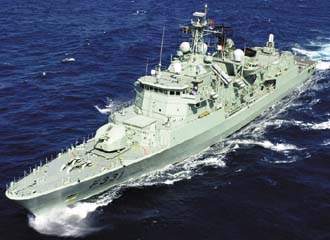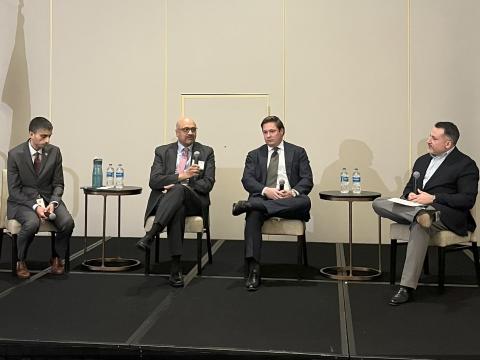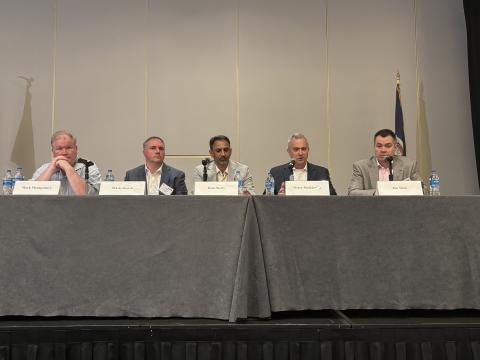Technology Propels Portuguese Defense Market
 |
A nation with a long maritime history, Portugal is heavily involved in European coastal monitoring and awareness programs. The nation’s technology firms are working actively in national and multinational consortia to support coastal security initiatives and related research. |
A founding member of NATO is weathering uncertain economic times by focusing on dual-use commercial and military technologies to energize its electronics and software industries. By launching a number of national initiatives supporting its defense sector,
“There’s a booming growth of innovative companies in the aeronautics, space and defense market that exploit dual-use technologies. Some Portuguese companies already have a significant presence in the
One trend affecting recent Portuguese national initiatives is the growing participation of privately held firms over publicly held institutions in government programs. The continuing emphasis on dual use has resulted in the formation of private consortia to develop new technologies. De Matos cites the example of the Portuguese Aerospace Industry Consortium, whose member companies and institutes are developing an unmanned aerial system (UAS) for civilian applications. He adds that the firms also are producing the communications and ground systems supporting the UAS platform.
National firms have developed new technologies and capabilities in a number of areas such as biometrics, geospatial information system (GIS) and electronics. In biometric identification and identity management systems, De Matos maintains that Portuguese companies have implemented one of the five largest databases worldwide. The system can identify individuals’ fingerprints and unique eye characteristics in real time from a database of 10 million people. He says these biometric identification systems already are installed in smart gates providing automated border control at several airports and the national border.
Another area that the Portuguese armed forces actively are developing is GIS. The technology recently was implemented to provide the Portuguese military’s joint chiefs of staff with data for operations and intelligence and to support decisions made by the individual services. GIS-based systems allow a more integrated and shared common operational picture, De Matos contends.
As a maritime nation, GIS technologies complement a variety of traditional missions such as search and rescue. De Matos explains that the technology is at the core of the Task Group for the Extension of the Continental Shelf (EMPEC), which also is supported by the Portuguese Navy’s Hydrographic Institute.
“Anticipating the completion of the EMPEC mission, 97 percent of the territory under Portuguese sovereignty will be under water, therefore, creating the technological foundations needed for the control and exploration of these new territories is of paramount importance,” he says. The GIS system has been tested and integrated successfully with similar NATO systems and those used by the community of Portuguese-speaking nations, he adds.
A Portuguese company specializing in software architecture and system testing is providing best-of-breed solutions and software-certifiable services and products for subsystems and interfaces. The firm’s services include system planning and analysis as well as system design, development, integration and maintenance. Additionally, the company provides engineering processes, definition solution design and support for the development of safety critical subsystems. De Matos says that the company’s expertise is being implemented in embedded and real-time systems, command and control applications, Earth observation, integrated logistics support, security and infrastructure, business intelligence, mobile services, and verification and validation.
 |
Despite budget restrictions resulting from the global economic crisis, Portugal continues to support the acquisition of communications equipment and computer networking infrastructure for its armed forces. |
The ICCS concept is based on a network of digital switching nodes featuring dynamic alternate routing. Multiple fiber optic links provide digital, contention-free communications paths between switching nodes. Single-node solutions are available for small ships and submarines. De Matos says that multinode arrangements guarantee a redundant structure and high survivability. But the ICCS in both versions represents a fully integrated system that provides internal communications, external communications and equipment remote control. He adds that the overall setup of the system—channel allocation, frequencies and operation modes—can be changed automatically or with a keystroke. “A powerful human interface, supported on a Windows-based graphical user interface, turns the control and management to the ship’s communications into a simple, trivial task,” he says.
Strategically, the Portuguese military currently is undertaking several major acquisitions supported by national industries. These include two new submarines with air-independent propulsion that feature communications, information systems and integration supplied by Portuguese industry. The first submarine is scheduled for delivery this year. The Ministry of Defense also is acquiring armored vehicles for the army and navy with communications systems provided by Portuguese companies.
A consortium of national firms is equipping the military with broadcast and ship-to-shore communications. Other major acquisitions include a military message-handling system and PRC-525 radios that are being produced in
The Portuguese industrial base is supporting the country’s military in a number of other ways. The military is acquiring a coastal and port vessel traffic system and integrated monitoring and information management systems capable of detecting small vessels from up to 12 nautical miles away. Industry is participating in system upgrades for the nation’s P-3 Orion maritime aircraft and the acquisition of two C-295 maritime surveillance aircraft. Additionally, the government is purchasing a vessel monitoring system for fishery control and is developing a national system—the Portuguese Integrated Network System—for security and emergencies, and a program is underway to map the continental shelf to depths of 6,000 meters (3.7 miles).
In addition to supporting national requirements, these military acquisitions reinforce broader international responsibilities.
“In these cases, they [acquisitions] provide the capability for allied multinational military force, taking into account common requirements for interoperability,” De Matos shares. He cites the example of a military message-handling system developed by Portuguese industry. The system consists of a line of products that comply with NATO standardization agreements and provide message switching, local distribution between end users and gateways for connection to ACP 127 military messaging networks.
Portuguese firms are contributing their expertise to support research and development within the framework of the European Defense Agency by participating in multinational consortia. Additionally, Portuguese companies have won several contracts with the European Space Agency for security applications and services.
In the near future, the main work available to the nation’s information technology industry will involve contracts supporting the Portuguese military’s main management information system (MIS) and the computer systems installed in the Defense Data Center (CDD). De Matos says that in the next few years, the CDD will become the main data center for defense-related MIS, as well as a reference for the nation’s public sector. This effort represents an opportunity for the information technology industry to meet the military’s operational requirements for data communications, networking and information assurance.
Additionally, major military programs will evolve over time. The key areas for change include the interoperability of systems, infrastructure and data; military message-handling systems; and crisis response in security and safety emergencies. Platforms and systems supporting maritime missions will continue to be one of
However, to achieve its acquisition goals,
But the largest cuts will focus on major armament systems, he says. Emphasis on information technology will remain and perhaps even grow, especially in areas such as surveillance and security systems, due to the positive contribution of dual-use technology to
WEB RESOURCES
Portuguese Industrial Association: www.aip.pt
Portuguese Ministry of National Defense (Portuguese language): www.mdn.gov.pt




Comments